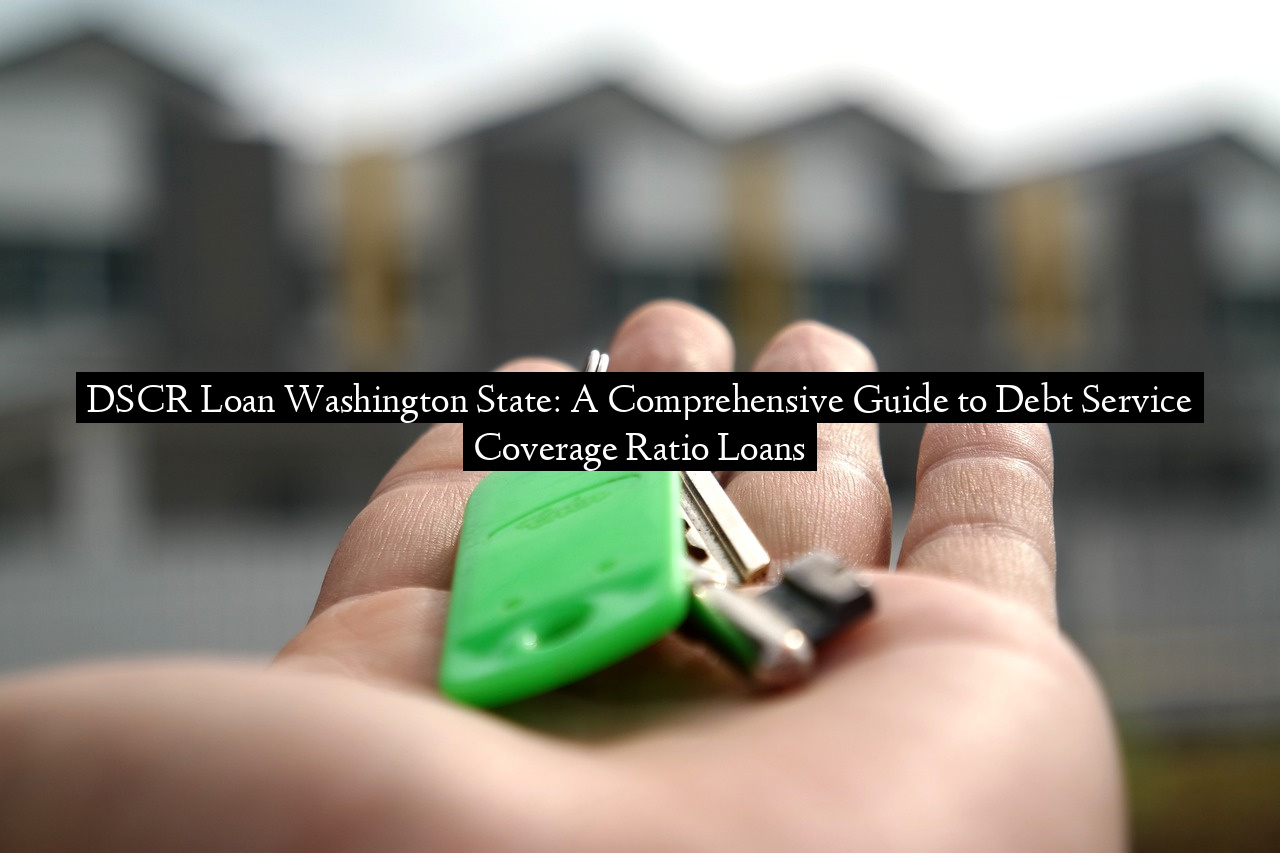Are you a Washington State resident looking for financing options for your business or real estate investments? If so, you may have come across the term “DSCR loan.” In this blog article, we will provide you with a detailed and comprehensive guide to DSCR loans in Washington State, covering everything from what they are and how they work to their benefits and eligibility criteria. Whether you are a seasoned entrepreneur or a first-time borrower, this article will equip you with the knowledge you need to make informed decisions about DSCR loans.
Before diving into the specifics of DSCR loans, let’s begin by understanding the concept of debt service coverage ratio (DSCR). The DSCR is a financial metric that lenders use to assess the ability of a borrower to meet their loan repayment obligations. It is calculated by dividing the borrower’s operating income by their total debt service, including principal and interest payments. A higher DSCR indicates a lower risk for lenders, as it demonstrates the borrower’s capacity to cover their debt payments comfortably.
What are DSCR Loans?
DSCR loans are a specialized form of financing that takes into account the debt service coverage ratio. Unlike traditional loans that primarily focus on credit scores and collateral, DSCR loans prioritize the borrower’s ability to generate sufficient income to cover their loan payments. These loans are commonly used for commercial real estate projects, such as purchasing or refinancing income-generating properties, as well as for business acquisitions or expansions. By considering the borrower’s DSCR, lenders can better assess the borrower’s financial health and the likelihood of loan repayment.
Types of DSCR Loans
There are different types of DSCR loans available in Washington State, depending on the specific needs and circumstances of the borrower. One common type is the DSCR commercial real estate loan, which is designed for financing income-producing properties like office buildings, retail centers, or apartment complexes. Another type is the DSCR business acquisition loan, which assists entrepreneurs in acquiring an existing business while ensuring their ability to cover the loan payments through the business’s cash flow. Additionally, DSCR loans can be used for refinancing existing debt, providing borrowers with the opportunity to improve their loan terms or consolidate multiple loans into a single payment.
Understanding the Eligibility Criteria
To qualify for a DSCR loan in Washington State, borrowers must meet certain eligibility criteria set by lenders. While each lender may have specific requirements, there are common factors considered across the board.
Credit Scores and Financial History
One of the primary factors lenders assess is the borrower’s creditworthiness. A good credit score and a positive financial history demonstrate a borrower’s ability to manage their debts responsibly. Lenders typically prefer borrowers with credit scores above a certain threshold, which may vary depending on the lender and the specific loan program. It is essential to review and understand your credit report before applying for a DSCR loan to ensure its accuracy and address any potential issues.
Debt Service Coverage Ratio Threshold
The debt service coverage ratio threshold is a crucial factor in DSCR loan eligibility. Lenders typically require a minimum DSCR to mitigate the risk associated with loan repayment. The specific threshold may vary depending on the lender, the type of loan, and the borrower’s financial circumstances. A higher DSCR will increase your chances of qualifying for a DSCR loan, as it indicates a more comfortable ability to cover your loan payments. If your current DSCR falls below the threshold, there are strategies and tips later in this article to help you improve it.
Income Documentation
Borrowers seeking a DSCR loan must provide comprehensive income documentation to lenders. This documentation typically includes financial statements, tax returns, bank statements, and proof of rental income, if applicable. Lenders analyze this documentation to verify the borrower’s income stability and assess their ability to generate sufficient cash flow to cover loan payments. It is essential to ensure that your income documentation is accurate, up-to-date, and organized to expedite the loan application process.
Collateral and Asset Evaluation
In addition to the debt service coverage ratio, lenders also consider the collateral or assets that borrowers can offer as security for the loan. Collateral can include real estate properties, equipment, or other valuable assets. The value and quality of the collateral play a role in determining the loan amount, interest rate, and overall loan terms. Lenders typically require professional appraisals and evaluations to assess the collateral’s value and determine its eligibility for securing the loan.
The Application Process: Step-by-Step
Once you meet the eligibility criteria, it’s time to navigate the application process for a DSCR loan in Washington State. While the specific steps may vary depending on the lender, the following is a general overview of what to expect:
Step 1: Research and Identify Potential Lenders
Start by researching and identifying potential lenders who offer DSCR loans in Washington State. Look for lenders with experience and a good reputation in providing DSCR loans to borrowers in your industry or specific financing needs. Consider factors such as interest rates, loan terms, customer service, and the lender’s willingness to work with borrowers in your financial situation.
Step 2: Gather and Organize Required Documentation
Before starting the application process, gather and organize all the required documentation. This includes financial statements, tax returns, bank statements, proof of rental income, and any other income documentation specified by the lender. Ensure that all documents are accurate, up-to-date, and readily accessible to expedite the application process.
Step 3: Pre-qualification and Loan Pre-Approval
Some lenders may offer a pre-qualification process to assess your eligibility for a DSCR loan before submitting a formal application. Pre-qualification typically involves providing basic financial information and allows lenders to provide an estimate of the loan amount and terms you may qualify for. If you meet the pre-qualification requirements, you can proceed to the formal loan pre-approval stage, where the lender conducts a more detailed analysis of your financial information.
Step 4: Complete the Loan Application
Complete the loan application provided by the lender. The application will require detailed information about your personal and financial background, the purpose of the loan, the property or business being financed, and the requested loan amount. Pay close attention to accuracy and completeness, as any errors or missing information may delay the loan approval process.
Step 5: Submit the Application and Documentation
Submit your completed loan application along with all the required documentation to the lender. Ensure that all documents are organized, legible, and in the required format. Consider providing a cover letter that summarizes your loan request, highlights your strengths as a borrower, and addresses any potential concerns upfront.
Step 6: Loan Processing and Underwriting
Once the lender receives your application and documentation, they will initiate the loan processing and underwriting stage. During this stage, the lender will review your financial information, conduct a credit check, evaluate the collateral, and assess the debt service coverage ratio. They may also request additional documentation or clarification if needed. This stage can take several weeks, so it is essential to be patient and responsive to any requests from the lender.
Step 7: Loan Approval and Closing
If your application meets the lender’s criteria and passes the underwriting process, you will receive a loan approval. The lender will provide you with a loan commitment letter, which outlines the approved loan amount, interest rate, repayment terms, and any conditions or contingencies. Review the loan commitment letter carefully and seek professional advice if needed. If you are satisfied with the terms, you can proceed to the loan closing, where you will sign the necessary documents and receive the loan funds.
Pros and Cons of DSCR Loans
DSCR loans offer several advantages and disadvantages compared to traditional financing options. By understanding these pros and cons, you can make an informed decision about whether a DSCR loan is the right choice for your financing needs.
Advantages of DSCR Loans
1. Lower Interest Rates: DSCR loans often come with competitive interest rates, especially for borrowers with strong financial profiles and high debt service coverage ratios.
2. Flexible Repayment Terms: Lenders may offer flexible repayment terms tailored to the borrower’s specific needs and cash flow. This flexibility can help borrowers manage their loan payments more effectively.
3. Increased Borrowing Capacity: DSCR loans assess a borrower’s ability to generate income rather than relying solely on collateral. This approach can provide borrowers with higher borrowing capacity compared to traditional loans.
Disadvantages of DSCR Loans
1. Stringent Eligibility Criteria: DSCR loans often have stricter eligibility criteria compared to traditional loans. Borrowers must meet specific requirements related to credit scores, income documentation, and debt service coverage ratios.
2. Limited Use for Non-Income Producing Assets: DSCR loans are primarily designed for income-generating properties or businesses. If you intend to finance assets without a reliable income stream, alternative financing options may be more suitable.
3. Potential Risks in Cash Flow Variability: If the income generated by the financed property or business experiences significant fluctuations, borrowers may face challenges in meeting theirdebt service obligations. It is crucial to carefully analyze the stability and predictability of the cash flow before opting for a DSCR loan.
DSCR Loan vs. Traditional Financing: A Comparative Analysis
When considering financing options, it is essential to compare DSCR loans with traditional financing to determine which option best suits your needs. Here’s a comparative analysis of DSCR loans and traditional financing:
Focus on Cash Flow vs. Collateral
Traditional financing options often prioritize collateral, such as real estate or other assets, as security for the loan. DSCR loans, on the other hand, focus on the borrower’s ability to generate sufficient cash flow to cover loan payments. This distinction makes DSCR loans more suitable for borrowers with strong income-generating properties or businesses but limited collateral.
Eligibility Criteria
DSCR loans generally have stricter eligibility criteria compared to traditional financing. Traditional loans often emphasize credit scores and collateral value, while DSCR loans require a higher debt service coverage ratio and a proven track record of generating income. If you have a strong cash flow but a lower credit score, a DSCR loan may be a more viable option.
Loan Amount and Terms
The loan amount and terms can vary between DSCR loans and traditional financing options. DSCR loans may offer higher borrowing capacity based on the income generated by the property or business. Traditional loans, on the other hand, may have lower borrowing limits but more flexible terms. Evaluating your specific financing needs and long-term goals will help determine which option is more suitable for you.
Interest Rates
Interest rates can vary between DSCR loans and traditional financing, depending on the lender and the borrower’s financial profile. DSCR loans may offer competitive interest rates, especially for borrowers with a high debt service coverage ratio and strong cash flow. Traditional loans may have more standardized interest rates, but they may be influenced by factors such as credit scores and collateral value.
Tips for Finding the Best DSCR Loan Lenders in Washington State
When searching for DSCR loan lenders in Washington State, it’s important to find a reputable lender that aligns with your financing needs. Here are some tips to help you find the best DSCR loan lenders:
Research and Compare Lenders
Take the time to research and compare different DSCR loan lenders in Washington State. Look for lenders with a proven track record of providing DSCR loans and positive customer reviews. Consider factors such as interest rates, loan terms, customer service, and their experience in your specific industry or financing needs.
Evaluate Reputation and Credibility
Assess the reputation and credibility of potential lenders. Look for lenders who are transparent, responsive, and have a strong presence in the industry. Check online reviews, testimonials, and ratings to gauge the experiences of other borrowers. A reputable lender will prioritize your financial goals and provide personalized guidance throughout the loan process.
Consider Flexibility and Customization
Opt for a lender that offers flexibility and customization options for DSCR loans. Look for lenders who are willing to tailor loan terms to your specific needs and cash flow requirements. A lender that understands your unique circumstances and provides flexible repayment options can help you manage your loan effectively.
Seek Recommendations and Professional Advice
Ask for recommendations from trusted professionals, such as accountants, financial advisors, or industry peers who have experience with DSCR loans. They can provide valuable insights and recommendations based on their knowledge and expertise. Additionally, consider seeking professional advice throughout the loan process to ensure you make informed decisions.
Case Studies: Success Stories of DSCR Loan Borrowers
Real-life case studies can provide inspiration and guidance for borrowers considering DSCR loans in Washington State. Here are a few examples of successful DSCR loan borrowers:
Case Study 1: Expanding a Retail Business
John, a small business owner, wanted to expand his retail business by opening a new location. However, traditional lenders were hesitant to provide financing due to John’s limited collateral and lower credit score. John opted for a DSCR loan, showcasing his strong cash flow and high debt service coverage ratio. With the DSCR loan, John successfully opened the new location, increased his revenue, and managed his loan payments comfortably.
Case Study 2: Acquiring an Apartment Complex
Sarah, an experienced real estate investor, identified a promising apartment complex for acquisition. However, the property required substantial financing, and Sarah wanted a loan that considered the property’s income potential rather than relying solely on her collateral. Sarah secured a DSCR loan, leveraging the property’s rental income and her strong cash flow. The DSCR loan allowed Sarah to acquire the apartment complex and generate significant returns on her investment.
Case Study 3: Refinancing a Business Loan
Mark, a small business owner, had multiple loans with varying interest rates and repayment terms. He sought a solution to consolidate his debts and improve his cash flow. Mark opted for a DSCR loan to refinance his existing loans into a single payment with more favorable terms. The DSCR loan not only simplified his financial obligations but also reduced his interest expenses and provided him with additional working capital to grow his business.
Frequently Asked Questions about DSCR Loans
When exploring DSCR loans, it’s common to have questions. Here are answers to some frequently asked questions about DSCR loans in Washington State:
Q: What is a Debt Service Coverage Ratio (DSCR)?
A: The DSCR is a financial metric that measures a borrower’s ability to cover their loan payments. It is calculated by dividing the borrower’s operating income by their total debt service.
Q: What is the minimum DSCR required for a DSCR loan?
A: The minimum DSCR required for a DSCR loan varies depending on the lender, the loan program, and the borrower’s financial circumstances. Generally, lenders prefer a higher DSCR to minimize the risk associated with loan repayment.
Q: Can I improve my DSCR to qualify for a DSCR loan?
A: Yes, you can improve your DSCR by increasing your income or decreasing your debt service obligations. Strategies to improve your DSCR include increasing revenue, cutting expenses, paying off existing debts, or refinancing existing loans with more favorable terms.
Q: How long does the DSCR loan application process take?
A: The DSCR loan application process can take several weeks, depending on various factors such as the complexity of the loan, the lender’s processes, and the thoroughness of your documentation. It is important to be patient and responsive during the process to expedite the loan approval.
Tips for Improving Your Debt Service Coverage Ratio
If your current DSCR falls below the threshold required to qualify for a DSCR loan, there are strategies and tips you can employ to improve it:
1. Increase Cash Flow
Look for ways to boost your income or generate additional sources of revenue. This can include increasing sales, diversifying your product or service offerings, or exploring new markets.
2. Reduce Debt Service Obligations
Consider paying off existing debts or refinancing loans with more favorable terms. This can help lower your monthly debt service payments and improve your DSCR.
3. Cut Expenses
Review your expenses and identify areas where you can reduce costs without compromising the quality of your operations. This can include renegotiating contracts, finding more cost-effective suppliers, or implementing efficiency measures.
4. Optimize Rental Income
If you own income-generating properties, analyze the rental rates and consider adjusting them to align with market conditions. Additionally, strive to minimize vacancies and increase tenant retention to maximize your rental income.
5. Seek Professional Advice
Consult with financial advisors, accountants, or business consultants who specialize in DSCR loans. They can provide tailored advice based on your specific financial situation and help you develop strategies to improve your DSCR.
In conclusion, DSCR loans can be a valuable financing option for businesses and real estate investors in Washington State. Understanding the intricacies of DSCR loans, from eligibility criteria to application processes, is crucial for making informed financial decisions. By following the comprehensive guide provided in this article, you are equipped with the knowledge to navigate the world of DSCR loans confidently. Remember to carefully assess your financial situation, compare lenders, and consider professional advice before proceeding with a DSCR loan application. With the right approach, a DSCR loan can provide the necessary funds to fuel your entrepreneurial or investment aspirations.



